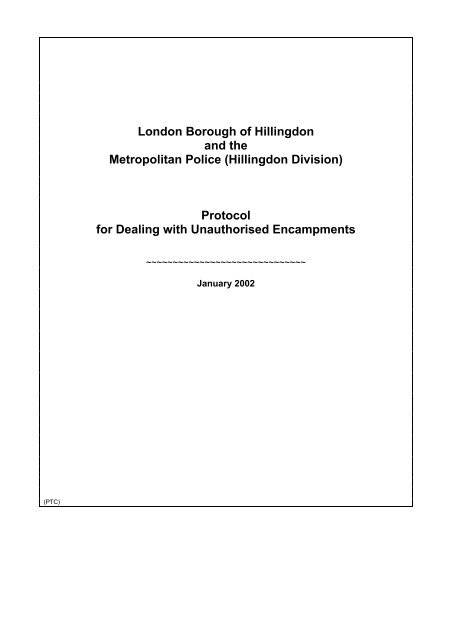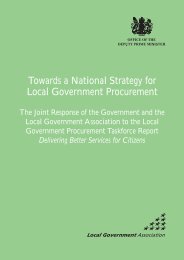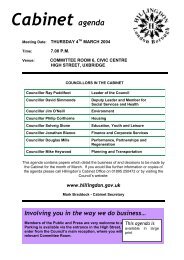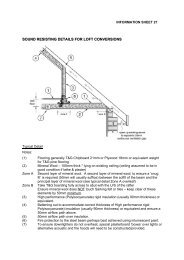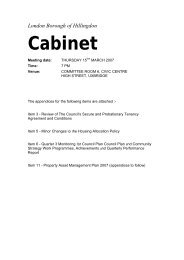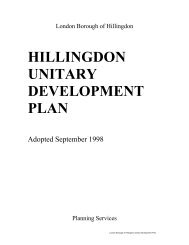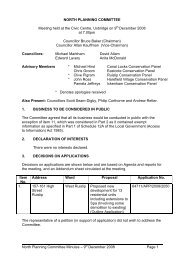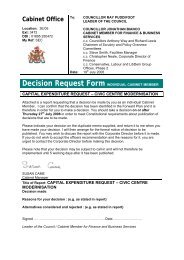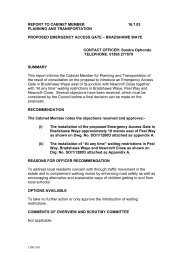Protocol for Dealing with Unauthorised Encampments - London ...
Protocol for Dealing with Unauthorised Encampments - London ...
Protocol for Dealing with Unauthorised Encampments - London ...
Create successful ePaper yourself
Turn your PDF publications into a flip-book with our unique Google optimized e-Paper software.
<strong>London</strong> Borough of Hillingdon<br />
and the<br />
Metropolitan Police (Hillingdon Division)<br />
<strong>Protocol</strong><br />
<strong>for</strong> <strong>Dealing</strong> <strong>with</strong> <strong>Unauthorised</strong> <strong>Encampments</strong><br />
~~~~~~~~~~~~~~~~~~~~~~~~~~~~~~<br />
January 2002<br />
(PTC)
Date:…………………………
APPENDIX A<br />
INFORMATION TO BE PROVIDED<br />
The following in<strong>for</strong>mation will be provided to minimise the impact on communities<br />
a) Rubbish must not be tipped – ask the local authority <strong>for</strong> refuse bags and use them.<br />
b) Small groups are more likely to be tolerated than large groups.<br />
c) Trespassers should not behave in a manner likely to cause members of the public to<br />
feel threatened or to disrupt the community – any complaints from the public will be<br />
taken into account in deciding what action to take.<br />
d) No damage must be caused to the site including the land.<br />
e) Vehicles should not be driven unnecessarily around the site.<br />
f) No noise nuisance should be caused.<br />
g) Only park on land not needed <strong>for</strong> another purpose.<br />
Police and the Local Authority have a statutory duty to reduce crime and disorder.<br />
This is relevant and <strong>for</strong> the benefit of all communities, settled or otherwise. To that end<br />
Trespassers must also be in<strong>for</strong>med that if they do not leave <strong>with</strong>in a reasonable time or<br />
their behaviour causes disruption to the settled community, there are a number of options<br />
available which are:-<br />
a) The Police or local authority powers to evict trespassers under the provisions of<br />
Sections 61 and 77 of the Criminal Justice and Public Order Act 1994 may be<br />
invoked.<br />
b) There may be a Police presence near the site in order to respond to any public<br />
concerns regarding anti - social or unlawful activities.<br />
c) Police have the powers to stop all vehicles on a public road and request the<br />
necessary documentation and assess the condition of vehicles.<br />
d) Any motorist unable to produce their documents will be reported at the time <strong>for</strong> the<br />
relevant offences and appropriate <strong>for</strong>ms will be issued to allow the opportunity <strong>for</strong><br />
documents to be produced. Photographs can be taken, <strong>with</strong> the consent of the<br />
driver, in order to preserve evidence of the identity of the alleged offenders.<br />
Identification of offenders can be difficult to prove in such circumstances.<br />
e) Photographs of the site may be taken upon arrival and throughout the period of the<br />
encampment. This is in order to establish if offences are being committed and<br />
conversely to protect Trespassers against unfounded allegations.<br />
f) If offences, e.g., criminal damage, are committed any suspects identified may be<br />
arrested.<br />
g) Police will liaise <strong>with</strong> other en<strong>for</strong>cement agencies as appropriate.
DECISION MAKING AFTER A TRESPASS – GRAVITY FACTORS<br />
APPENDIX B<br />
The first supervisor on scene, whether from the Police or the Council, must complete this<br />
<strong>for</strong>m to assist in the decision making progress. Only a Police Inspector or above may<br />
authorise eviction using Section 61 CJPO Act, 1994. The Senior Parks Patroller is<br />
authorised on behalf of the Council to evict Trespassers using Section 77 CJPO Act,<br />
1994.<br />
Instructions <strong>for</strong> supervisors<br />
‣ Complete the <strong>for</strong>m below <strong>with</strong> in<strong>for</strong>mation about the trespass.<br />
‣ Review the statement of intent<br />
‣ Review the in<strong>for</strong>mation about the trespass and decide if eviction of the trespassers<br />
using police or other powers is appropriate<br />
‣ Complete a risk assessment if immediate eviction is appropriate.<br />
Gravity factors<br />
Address of land<br />
………………………………………………………………………………………………………<br />
………………………………………………………………………………………………………<br />
…………………………<br />
Type and Condition of land (council/private/business/residential/public amenity)<br />
………………………………………………………………………………………………………<br />
………………………………………………………………………………………………………<br />
…………………………<br />
Use of land (<strong>for</strong> example, school or car park/damage caused/suitability <strong>for</strong> residence, loss<br />
of public amenity)<br />
………………………………………………………………………………………………………<br />
………………………………………………………………………………………………………<br />
…………………………<br />
Vehicles (number and type of vehicles, total including caravans, traffic implications)<br />
………………………………………………………………………………………………………<br />
………………………………………………………………………………………………………<br />
…………………………<br />
Trespassers (number, behaviour, length of time resident)<br />
………………………………………………………………………………………………………<br />
………………………………………………………………………………………………………<br />
…………………………<br />
Landowner/occupier (in attendance/views/requests)<br />
………………………………………………………………………………………………………<br />
………………………………………………………………………………………………………<br />
…………………………<br />
Local authority (name of lead at LA present/views)<br />
………………………………………………………………………………………………………<br />
………………………………………………………………………………………………………<br />
…………………………<br />
Individual Welfare issues (elderly/sickness/pregnancy/time of day)
………………………………………………………………………………………………………<br />
………………………………………………………………………………………………………<br />
…………………………<br />
Environmental Health issues (rubbish/health hazards/presence of animals)<br />
………………………………………………………………………………………………………<br />
………………………………………………………………………………………………………<br />
…………………………<br />
Other factors (policing problems/criminal intelligence/implications of an<br />
eviction/contingencies <strong>for</strong> serious disorder/residents’ views/available resources)<br />
………………………………………………………………………………………………………<br />
………………………………………………………………………………………………………<br />
………………………………………………………………………………………………………<br />
…………………………<br />
Other Factors <strong>for</strong> the Council to consider (education needs/social service<br />
needs/housing needs)<br />
………………………………………………………………………………………………………<br />
………………………………………………………………………………………………………<br />
………………………………………………………………………………………………………<br />
………………………………<br />
Record decision in book 198<br />
Signed ……………………………………<br />
Date:…………………………
RECORD OF SUBSEQUENT COMPLAINTS FROM THE PUBLIC<br />
APPENDIX C<br />
Details of Complaint<br />
Date Received<br />
…………………………………………………………………………………………………<br />
…………………………………………………………………………………………………<br />
…………………………………………………………………………………………………<br />
…………………………………………………………………………………………………<br />
…………………………………………………………………………………………………<br />
…………………………………………………………………………………………………<br />
…………………………………………………………………………………………………<br />
…………………………………………………………………………………………………<br />
…………………………………………………………………………………………………<br />
…………………………………………………………………………………………………<br />
…………………………………………………………………………………………………<br />
…………………………………………………………………………………………………<br />
…………………………………………………………………………………………………<br />
…………………………………………………………………………………………………<br />
…………………………………………………………………………………………………<br />
…………………………………………………………………………………………………<br />
…………………………………………………………………………………………………<br />
…………………………………………………………………………………………………


